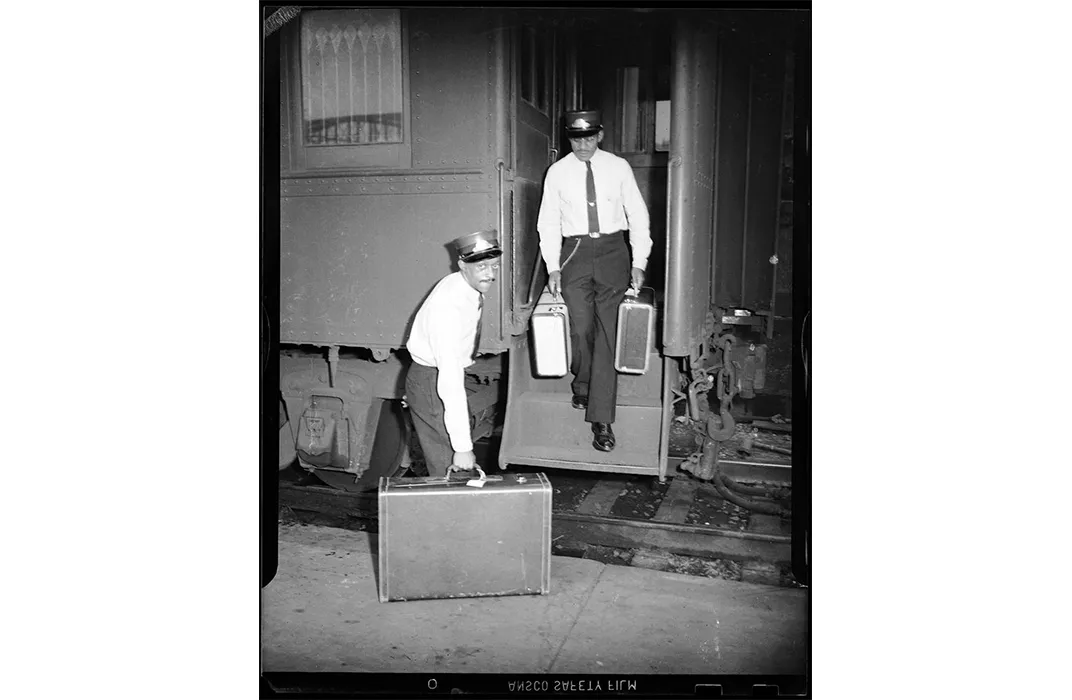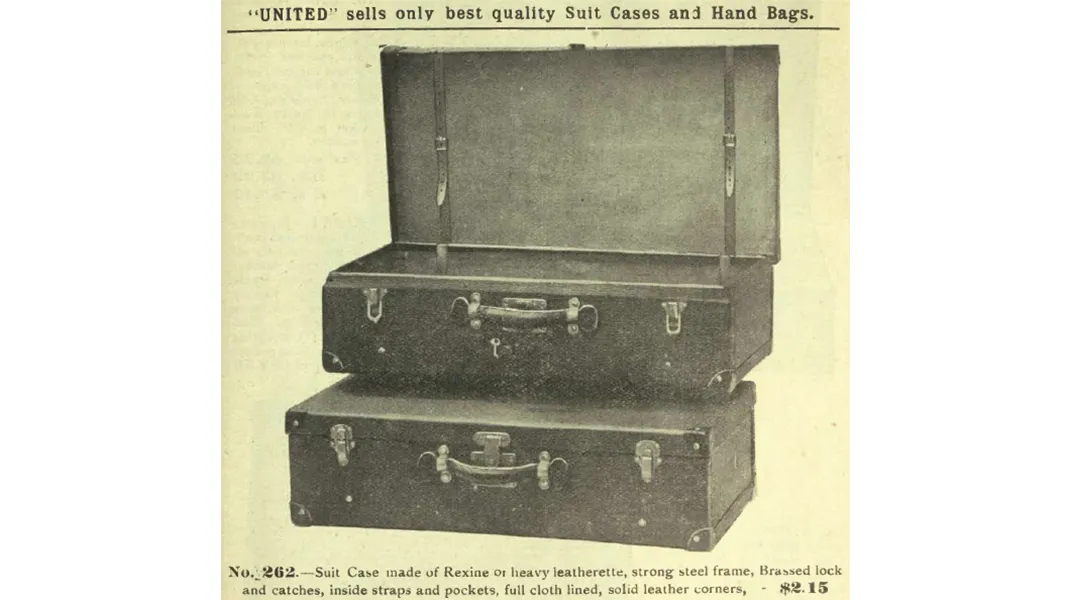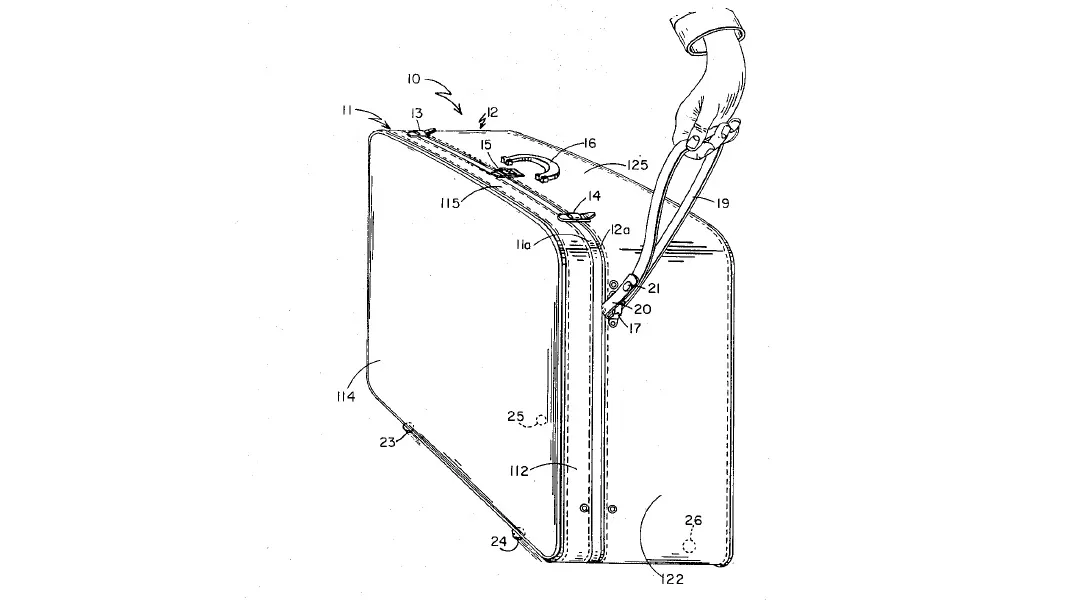The History of the Humble Suitcase
Modern luggage has been constantly reinvented during its short 120-year history
/https://tf-cmsv2-smithsonianmag-media.s3.amazonaws.com/filer/07/0c/070ca91e-f58e-482f-bb97-9415a810b159/b-1911_stateroom_trunk.jpg)
When Phileas Fogg decides to circle the globe in Around the World in 80 Days, the 1873 novel by Jules Verne, he doesn't take a suitcase. “We'll have no trunks,” he says to his servant Passepartout, “only a carpet bag, with two shirts and three pairs of stockings for me, and the same for you. We'll buy our clothes on the way.”
At the time, the suitcase as we know it today hardly existed. In Verne's day, proper travel required a hefty trunk built of wood, leather, and often a heavy iron base. The best trunks were waterproofed with canvas or tree sap, as steamships were a reigning mode of travel. Without this protection, a suitcase in the hold of a heaving, leaky ship would probably have been wet within a few hours, and crushed by sliding trunks within a few more.
When the suitcase finally did catch on at the end of the 19th century, it was quite literally a case for suits. A typical suitcase came equipped with an inner sleeve for storing shirts, and sometimes a little hat box on the side. But even in the early 20th century, the “dress-suit case” was only one of countless styles of container that travelers could buy, from steamer trunks to club bags to Eveready portable wardrobes. These were boom times for the baggage business.
Which, of course, probably seems like an utterly useless fact. Most people care about containers much less than they care about the things containers contain—the pairs of pants, the paperback books, the miniature bottles of shampoo. But the history of the suitcase spans every major transportation revolution since the steamship. And this means that suitcases carry a lot more than spare socks and underwear—they carry in their design a subtle history of human movement.

It's a good thing Phileas Fogg didn't take a trunk, because dragging one from steamship to railroad to carriage to hot air balloon would have ruined his rapid pace. Trunk-laden travel was becoming increasingly illogical as long-distance transportation grew more common and diverse. Up to that point, tourism had begun a decidedly upper-class phenomenon, and the rich could rely on an army of hired hands to carry luggage. In the 18th century, young European elites on the Grand Tour had often traveled with several servants in a coach filled with trunks and furniture. There wasn't sufficient incentive to revise an inconvenient design while rich travelers simply relied on railway porters and hotel bellhops. (Indeed, when Fogg meets an Indian princess along the way, he buys luggage for her, and the pair is soon carried to their steamship by palanquin—basically a chair with handles that's lifted with human labor—with “their luggage brought up after on a wheelbarrow.”)
But the late 19th century marked a pivot point in the history of transportation: it was the beginning of mass tourism, of travel for travel's sake (as opposed to, say, pilgrimages to Jerusalem or migration to industrial mill towns.) Humans had long traveled for the sake of curiosity and exploration, of course, but by 1900 or so, hotels in Switzerland were recording millions of overnight stays per year, and a summer day could draw hundreds of thousands of visitors to British beaches. Travel wasn't just for the wealthy anymore.

Suitcases began as an afterthought in the luggage and leather goods business, but they soon became the very symbol of travel. An 1897 wholesale price list included the words “suit case” only twice in a 20-page list of luggage types. In a 1907 T. Eaton & Co. catalog, trunks took up a full page while suitcases share a page with club bags and valises. In a 1911 United Company catalog, however, around 40 percent of the advertisements were for suitcases. (It's worth pointing out that these catalogs were from North America, where migration required people—and not just the wealthy—to carry their own belongings far and often).
Early suitcases (usually called “suit cases” or “suit-cases”) were lighter and more portable than trunks, but they were still bulky by today's standards. Leather, wicker or thick rubbery cloth was stretched over a rigid wood or steel frame. Corners were rounded out using brass or leather caps. Such suitcases tended to have roughly the proportions of a hardback book: flattened and easy to carry, with a handle on the long side. Until steamship travel declined during the mid-20th century, many were advertised as waterproof. Lightweight models were often marketed specifically to women.
As trunks went out of style, suitcases took on not just practical but also cultural significance. By the 1920s, suitcases featured in books such as The Hardy Boys and such films as The Woman in the Suitcase, as a literary symbol for both mobility and mystery—perhaps filled with gold, photographs, or simply a stranger's possessions. During the Great Depression, farmers who worked fields away from home were called “suitcase farmers.”
Suitcases still had a ways to go before achieving their present form, though. With the rapid expansion in automobile travel during in the 1920s, and a more gradual expansion of air travel a couple decades later, suitcases found new applications but also new kinds of competition. A 1933 business report written to President Franklin Roosevelt by Hugh S. Johnson, an administrator in the National Recovery Administration, put it this way: “With the increase in the use of automobiles, it has become easy to utilize simple cardboard containers secured at little or no cost, in the back of the automobile in lieu of luggage.” Suitcases, in other words, had to get lighter and cheaper if they wanted to compete. The robust wood, steel, and heavy leather suitcase gave way to cardboard and plastic models that emphasized “modern” materials and convenience.
Think back now to the suitcases you can buy today. Many feature large pieces of rounded hard plastic (a practice which seems to have started in the 1960s), or are built with synthetic fabrics stretched over minimalist alloy frames. Zippers have largely replaced clasps, and few suitcases are specifically waterproof. Perhaps most importantly, suitcases come in two distinct sizes—“carry-on” or “check-in”—both of which tend to come with wheels.
/https://tf-cmsv2-smithsonianmag-media.s3.amazonaws.com/filer/d4/d0/d4d080ac-95e8-453a-b769-791191bf61c0/42-44762024.jpg)
Essentially all these developments came in the last half-century or so, particularly with the onset of mass aviation. Unlike transportation by automobile, which takes a traveler from door to door, a long flight can require half a mile of walking during check-in, layovers, and arrival. And while a ship's hold or luggage car could store large amounts of luggage regardless of shape, an airplane's stowage areas have specific proportions and size limits. The suitcase had to adapt, as a 1970 patent by Bernard Sadow explained:
Whereas formerly luggage would be handled by porters and be loaded or unloaded at points convenient to the street, the large terminals of today, particularly air terminals, have increased the difficulty of baggage handling. Thus, it is often necessary for a passenger to handle his own baggage in an air, rail, or bus terminal. Further, where the passenger does handle his own luggage, he is often required to walk very great distances.

Sadow's patent, as you might have guessed, was the crucial innovation of the wheeled suitcase. 1970 may seem remarkably recent for such a useful development. (A wheeled trunk was patented in 1887, and a wheeled suitcase in 1945—those initial models simply didn't catch on). We have to remember that aviation had only recently become truly widespread, though: in the two decades before the patent, flights had increased their passenger totals by ten times, from 17 million in 1949 to 172 million in 1969. That was also the year that set records for the most hijackings in a year, with an astonishing 82—a fact which contributed to increasingly strict baggage checks that funneled passengers through longer lines on the way to centralized security checkpoints.
Luggage design remains tightly linked to aviation. Carry-on luggage (which, by the way, was transformed in 1987 with the wheeled “Rollaboard” bag and its now-ubiquitous collapsible handle) conforms to the dimensions of the airlines with the smallest storage area. When new weight restrictions for checked bags kicked in during the 2000s, meanwhile, practically every luggage manufacturer released new lightweight models to stay competitive. These suitcases tend to be vertical instead of horizontal, because of their wheels, and relatively stout and thick, because of airline restrictions on suitcase dimensions.
There's an irony to the shape of these modern suitcases. They've come a long way from the flat and stackable “dress-suit case,” shaped like a big hardback book. Today's luggage instead fits the rough proportions of a big shoe box—and this gives it almost the same shape as those unwieldy trunks that Phileas Fogg preferred to leave at home. A century of revolution in transportation, in other words, seems to have brought us back to the hefty trunk shape that the first suitcases replaced. Just as we might pack and re-pack our belongings to fit our luggage, we make and re-make our luggage to fit our built world.